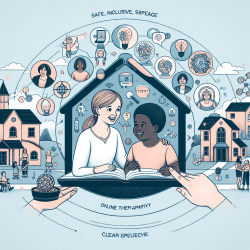The field of autism spectrum disorders (ASD) is continuously evolving, with new research shedding light on the complex behaviors associated with this condition. One such area of focus is the repetitive and restricted behaviors (RRBs) that are characteristic of ASD. These behaviors can range from simple motor actions to complex rituals and are crucial in determining the severity of ASD as per the DSM-5 guidelines.
The Biopsychological Basis of RRBs
A recent systematic review titled "Biopsychological correlates of repetitive and restricted behaviors in autism spectrum disorders", conducted by Comparan-Meza et al., provides an in-depth analysis of the underlying mechanisms that contribute to RRBs. The study highlights several key factors:
- Neurotransmission Alterations: Changes in neurotransmitters such as dopamine, serotonin, and GABA are linked to RRBs. These imbalances can affect brain connectivity and behavior regulation.
- Brain Volume and Growth Factors: Abnormal brain volumes and growth factor levels are associated with the development and persistence of RRBs.
- Cognitive Flexibility and Behavioral Inhibition: Deficits in these areas can exacerbate RRBs by limiting an individual's ability to adapt to new situations or inhibit inappropriate responses.
- Environmental Influences: Non-stimulating environments may increase the frequency of RRBs, highlighting the importance of environmental enrichment in therapeutic settings.
Practical Applications for Practitioners
The insights from this research can be instrumental for practitioners seeking to refine their therapeutic approaches. Here are some ways practitioners can apply these findings:
- Tailored Interventions: By understanding the specific neurotransmitter imbalances or cognitive deficits present in a patient, practitioners can tailor interventions that target these areas directly.
- Cognitive Behavioral Strategies: Enhancing cognitive flexibility through targeted exercises can help reduce RRBs by improving the patient's ability to adapt to changes.
- Sensory Integration Techniques: Incorporating sensory integration strategies can help mitigate the effects of non-stimulating environments, thereby reducing RRBs.
- Parental Involvement: Educating parents about the biopsychological underpinnings of RRBs can empower them to support their child's development more effectively at home.
The Need for Continued Research
This review underscores the complexity of RRBs in ASD and highlights areas where further research is needed. By continuing to explore these biopsychological correlates, researchers can develop more effective interventions that address both lower- and higher-level RRBs. Practitioners are encouraged to stay informed about ongoing research developments to continually enhance their practice.
To read the original research paper, please follow this link: Biopsychological correlates of repetitive and restricted behaviors in autism spectrum disorders.










